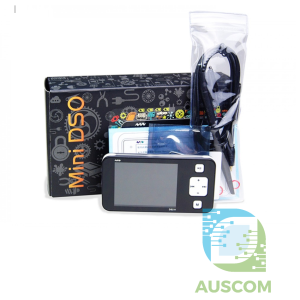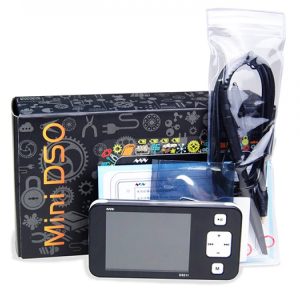At Auscom, we stand as Australia’s premier destination for all industrial electronics, control equipment, and tool requirements. With an unwavering commitment to excellence, innovation, and customer satisfaction, we’ve solidified our position as an industry leader. Our offerings extend to cutting-edge solutions and specialized products, with a spotlight on the pinnacle of signal analysis: high-performance digital oscilloscopes.
Unveiling Accuracy and Precision:
Welcome to our curated selection of high-performance digital oscilloscopes, meticulously engineered to cater to the exacting demands of modern electronic testing and signal analysis. Whether you’re an electronics hobbyist, a dedicated researcher, or a seasoned professional engineer, our oscilloscopes usher in unparalleled accuracy, supreme versatility, and a user experience that defies complexity.
Unlocking the Key Features:
- High Bandwidth and Sampling Rate: Our oscilloscopes boast impressive bandwidth capabilities, enabling the accurate capture of high-frequency signals. Bolstered by a rapid sampling rate, these instruments empower you to capture even the most transient events with the utmost precision.
- Deep Memory: Never relinquish a single detail with the expansive memory capacity of our oscilloscopes. Effortlessly capture and dissect extended-duration signals without compromising data resolution, ensuring that crucial insights remain firmly within your grasp.
- Intuitive User Interface: Navigating the intricate tapestry of settings becomes a seamless journey with our intuitive user interface. Tweak parameters, adjust trigger settings, and wield measurement tools with consummate ease, making your testing process efficient and frustration-free.
- Real-time Data Visualization: Witness signals spring to life with the high-refresh-rate displays of our oscilloscopes. Analyze waveforms, pulses, and transients as they unfold, equipping you with the capability to make timely, informed decisions.
- Advanced Triggering Options: Our oscilloscopes bestow an array of triggering options: edge, pulse width, video, and serial bus triggering. Pinpoint and capture specific events of interest with laser precision and graceful simplicity.
- Built-in Analysis Tools: Dive deeper into your data with the spectrum of built-in measurement and analysis tools. Engage in vital calculations, FFT analyses, and waveform mathematics directly on the oscilloscope, diminishing the necessity for external software.
- Versatile Connectivity: Connectivity is the cornerstone of efficiency, and our oscilloscopes offer a repertoire of options. USB, LAN, and GPIB interfaces facilitate seamless data transfer, remote control, and integration into automated test configurations.
- Portable and Benchtop Models: Navigate through our selection of portable and benchtop oscilloscopes, each tailored to suit your unique needs. Whether your endeavours require on-the-go testing or a stable laboratory setup, our arsenal offers the ideal solution.
- Upgradability and Flexibility: Stay abreast of the latest advancements via firmware updates and enhance your oscilloscope’s potential with modular options, including additional channels and protocol analysis capabilities.
FAQ for Oscilloscopes
Q1: What is an oscilloscope? An oscilloscope is an electronic test instrument used to visualize and analyze electrical signals in the form of waveforms. It displays amplitude, frequency, and other characteristics of signals in real-time, making it essential for diagnosing and troubleshooting electronic circuits.
Q2: How does an oscilloscope work? Oscilloscopes work by capturing electrical signals and displaying them on a screen. They use vertical and horizontal axes to represent voltage and time, allowing users to see how signals change over time. This visualization aids in identifying signal abnormalities, frequency variations, and more.
Q3: What are the types of oscilloscopes available? There are several types of oscilloscopes, including analog oscilloscopes, digital storage oscilloscopes (DSOs), digital phosphor oscilloscopes (DPOs), mixed-signal oscilloscopes (MSOs), and more. Each type offers unique features and advantages for different applications.
Q4: What factors should I consider when choosing an oscilloscope? When selecting an oscilloscope, consider bandwidth (signal frequency range), sample rate, number of channels, memory depth, and trigger capabilities. Your choice should align with your specific testing requirements and budget.
Q5: How is oscilloscope bandwidth important? Bandwidth determines an oscilloscope’s ability to accurately represent high-frequency signals. A rule of thumb is to choose an oscilloscope with a bandwidth five times higher than the highest frequency component of your signal.
Q6: What is the difference between analog and digital oscilloscopes? Analog oscilloscopes directly display the input signal’s voltage on a cathode-ray tube (CRT). Digital oscilloscopes convert the input signal into a digital format and store it in memory for analysis. Digital oscilloscopes offer more advanced features, signal storage, and convenient data sharing.
Q7: How do I interpret oscilloscope waveforms? Oscilloscope waveforms display voltage variations over time. The vertical scale represents voltage, while the horizontal scale represents time. The shape, amplitude, frequency, and any distortions in the waveform provide insights into the signal’s characteristics and potential issues.
Q8: What are some common oscilloscope applications? Oscilloscopes are used in various industries for tasks like circuit debugging, signal analysis, waveform characterization, protocol analysis, audio testing, and more. They are indispensable tools for electronics engineers, technicians, and researchers.
Q9: Can I use an oscilloscope for digital signal analysis? Yes, digital oscilloscopes can analyze digital signals, making them valuable for troubleshooting digital circuits, logic analysis, and debugging communication protocols. Mixed-signal oscilloscopes combine analog and digital channels for comprehensive testing.
Q10: How do I maintain and calibrate my oscilloscope? Regular calibration ensures the accuracy of your oscilloscope’s measurements. Many manufacturers offer calibration services, and some oscilloscopes have built-in calibration functions. Follow the manufacturer’s guidelines for maintenance and calibration procedures.
Q11: Where can I buy an oscilloscope? Oscilloscopes are available from electronics suppliers, specialized test equipment stores, and online retailers. Consider reputable brands with positive user reviews and ensure the chosen model meets your technical requirements.
Q12: Are there any safety precautions when using oscilloscopes? Yes, using oscilloscopes involves working with electrical circuits. Always follow safety guidelines, such as wearing appropriate protective gear, ensuring proper grounding, and disconnecting power sources before connecting probes or making adjustments.
Q13: Can I use an oscilloscope for audio and waveform analysis? Absolutely. Oscilloscopes are commonly used for audio analysis, including measuring signal distortion, frequency response, and noise levels. They can also visualize waveforms from musical instruments and audio devices.
Q14: What is the role of triggering in oscilloscopes? Triggering helps stabilize the displayed waveform by synchronizing the scope’s sweep with specific points in the input signal. This ensures a consistent and stable view of repetitive or complex waveforms.
Q15: How do I capture and save oscilloscope data? Digital oscilloscopes allow you to capture, save, and export waveform data to external devices or computers. This is useful for documentation, analysis, and sharing data with colleagues.
Remember, this FAQ provides general information about oscilloscopes. For specific technical details or recommendations, consult the manufacturer’s documentation or seek advice from experts in the field.
Culmination of Excellence:
Elevate your signal analysis prowess with our cutting-edge digital oscilloscopes. Enriched with advanced features, user-friendly interfaces, and unwavering measurement precision, these instruments transcend their role to become indispensable assets for electronics enthusiasts, dedicated researchers, and seasoned engineers alike. Venture into our comprehensive range today, and embark on an expedition to experience the raw power of precise signal analysis firsthand. At Auscom, precision isn’t just a promise; it’s a way of life.
-
Oscilloscopes
DSO211 DS211 Digital Oscilloscope Portable Pocket-Sized Nano Handheld Storage Mini ARM
$175.31 - $212.50 Inc. GSTThere is no AI review summary.


